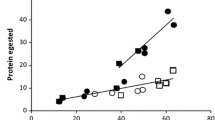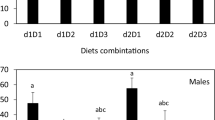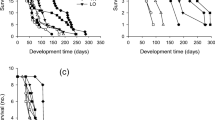Abstract
The nutritional value of alternative host plants for leaf-feeding insects such as caterpillars is commonly measured in terms of protein quantity. However, nutritional value might also depend on the quality of the foliar protein [i.e., the composition of essential amino acids (EAAs)]. A lack of comparative work on the EAA compositions of herbivores and their host plants has hampered the testing of this hypothesis. We tested the “protein quality hypothesis” using the tree-feeding caterpillars of Lymantria dispar (gypsy moth) and two taxonomically unrelated host plants, red oak (Quercus rubra) and sugar maple (Acer saccharum). Because L. dispar has higher fitness on oak than on maple, support for the hypothesis would be found if protein were of higher quality from oak than from maple. The whole-body EAA composition of L. dispar larvae was measured to estimate its optimum dietary protein composition, which was compared with the EAA compositions of oak and maple leaves. Contrary to the protein quality hypothesis, the EAA compositions of oak and maple were not significantly different in the spring. The growth-limiting EAAs in both tree species were histidine and methionine. Similar results were observed in the summer, with the exception that the histidine composition of oak was between 10 and 15 % greater than in maple leaves. The two main factors that affected the nutritional value of protein from the tree species were the quantities of EAAs, which were consistently higher in oak, and the efficiency of EAA utilization, which decreased from 80 % in May to <50 % in August. We conclude that the relative nutritional value of red oak and sugar maple for L. dispar is more strongly affected by protein quantity than quality. Surveys of many wild herbaceous species also suggest that leaf-feeding insects would be unlikely to specialize on plants based on protein quality.



Similar content being viewed by others
References
Addy ND (1969) Rearing the forest tent caterpillar on and artificial diet. J Econ Entomol 62:270–271
Anderson TR, Boersma M, Raubenheimer D (2004) Stoichiometry: linking elements to biochemicals. Ecology 85:1193–1202
Awmack CS, Leather SR (2002) Host plant quality and fecundity in herbivorous insects. Annu Rev Entomol 47:817–844
Barbehenn RV (1992) Digestion of uncrushed leaf tissues by leaf-snipping larval Lepidoptera. Oecologia 89:229–235
Barbehenn RV, Constabel CP (2011) Tannins in plant-herbivore interactions. Phytochemistry 72:1151–1565
Barbehenn RV, Jaros A, Lee G, Mozola C, Weir Q, Salminen J-P (2009) Tree resistance to Lymantria dispar caterpillars: importance and limitations of foliar tannin composition. Oecologia 159:777–788
Barbehenn RV, Niewiadomski J, Kochmanski J, Constabel CP (2012) Limited effect of reactive oxygen species on the composition of susceptible essential amino acids in the midguts of Lymantria dispar caterpillars. Arch Insect Biochem Physiol 81:160–177
Barbehenn RV, Niewiadomski J, Pecci C, Salminen J-P (2013) Physiological benefits of feeding in the spring by Lymantria dispar caterpillars on red oak and sugar maple leaves: nutrition vs. oxidative stress. Chemoecology (in press)
Berenbaum MR (1995) Turnabout is fair play: secondary roles for primary compounds. J Chem Ecol 21:925–940
Bernays EA, Chapman RF (1994) Host-plant selection by phytophagous insects. Chapman & Hall, New York
Bi JL, Felton GW, Mueller AJ (1994) Induced resistance in soybean to Helicoverpa zea: role of plant protein quality. J Chem Ecol 20:183–198
Bi JL, Murphy JB, Felton GW (1997) Antinutritive and oxidative components as mechanisms of induced resistance in cotton. J Chem Ecol 23:97–117
Broadway RM, Duffey SS (1986) Plant proteinase inhibitors: mechanism of action and effect on the growth and digestive physiology of larval Heliothis zea and Spodoptera exigua. J Insect Physiol 32:827–833
Broadway RM, Duffey SS (1988) The effect of plant protein quality on insect digestive physiology and the toxicity of plant proteinase inhibitors. J Insect Physiol 34:1111–1117
Brodbeck BV, Andersen PC, Mizell RF III (2006) Nutrient mediation of behavioral plasticity and resource allocation in a xylem-feeding leafhopper. Oecologia 165:111–122
Byers M (1971) Amino acid composition and in vitro digestibility of some protein fractions from three species of leaves of various ages. J Sci Food Agric 22:242–251
Byers M (1983) Extracted leaf proteins: their amino acid composition and nutritional quality. In: Telek L, Graham HD (eds) Leaf protein concentrates. AVI, Westport, CT, pp 135–175
Cassab GI (1998) Plant cell wall proteins. Annu Rev Plant Physiol Plant Mol Biol 49:281–309
Cohen SA, Michaud DP (1983) Synthesis of a fluorescent derivatizing reagent, 6-aminoquinolyl-N-hyroxysuccinimidyl carbamate, and its application for the analysis of hydrolysate amino acids via high-performance liquid chromatography. Anal Biochem 211:279–287
Edwards PJ, Wratten SD (1983) Wound induced defences in plants and their consequences for patterns of insect grazing. Oecologia 59:88–93
Evans JR (1989) Photosynthesis and nitrogen relationships in leaves of C3 plants. Oecologia 78:9–19
Feeny PP (1970) Seasonal changes in oak leaf tannins and nutrients as a cause of spring feeding by winter moth caterpillars. Ecology 51:565–581
Felton GW (1996) Nutritive quality of plant protein: sources of variation and insect herbivore responses. Arch Insect Biochem Physiol 32:107–130
Giovanelli J (1987) Sulfur amino acids of plants: an overview. Meth Enzymol 143:419–426
Haruta M, Major IT, Christopher ME, Patton JJ, Constabel CP (2001) A Kunitz trypsin inhibitor gene family from trembling aspen (Populus tremuloides Michx.): cloning, functional expression, and induction by wounding and herbivory. Plant Mol Biol 46:347–359
Hedin PA, Williams WP, Davis FM, Buckley PM (1990) Roles of amino acid, protein, and fiber in leaf-feeding resistance of corn to the fall armyworm. J Chem Ecol 16:1977–1996
Horie Y, Watanabe K (1983) Effect of various kinds of dietary protein and supplementation with limiting amino acids on growth, haemolymph components and uric acid excretion in the silkworm, Bombyx mori. J Insect Physiol 29:187–199
Karowe DN, Martin MM (1989) The effects of quantity and quality of diet nitrogen on the growth, efficiency of food utilization, nitrogen budget, and metabolic rate of fifth-instar Spodoptera eridania larvae (Lepidoptera: Noctuidae). J Insect Physiol 35:699–708
Kleiner KW, Ellis DD, McCown BH, Raffa KF (2003) Leaf ontogeny influences leaf phenolics and the efficacy of genetically expressed Bacillus thruingiensis cry1A(a) d-endotoxin in hybrid poplar against gypsy moth. J Chem Ecol 29:2585–2602
Ladron de Guevara O, Padilla P, Garcia L, Pino JM, Ramos-Elorduy J (1995) Amino acid determination in some edible Mexican insects. Amino Acids 9:161–173
Lee KP (2007) The interactive effects of protein quality and macronutrient imbalance on nutrient balancing in an insect herbivore. J Exp Biol 210:3236–3244
Liebhold AM, Gottschalk KW, Muzika R-M, Montgomery ME, Young R, O’Day K, Kelley B (1995) Suitability of North American tree species to the gypsy moth: a summary of field and laboratory tests. General technical report NE-211. Northeastern Forest Experimental Station, United States Department of Agriculture Forest Service
Mattson WA (1980) Herbivory in relation to plant nitrogen content. Annu Rev Ecol Syst 11:19–38
Metayer S, Seiliez I, Collin A, Duchene S, Mercier Y, Geraert P-A, Tesseraud S (2008) Mechanisms through which sulfur amino acids control protein metabolism and oxidative status. J Nutr Biochem 19:207–215
Meyer GA, Montgomery ME (1987) Relationships between leaf age and the food quality of cottonwood foliage for the gypsy moth, Lymantria dispar. Oecologia 72:527–532
Mollema C, Cole RA (1996) Low aromatic amino acid concentrations in leaf proteins determine resistance to Frankliniella occidentalis in four vegetable crops. Entomol Exp Appl 78:323–331
Montgomery ME (1982) Life-cycle nitrogen budget for the gypsy moth, Lymantria dispar, reared on artificial diet. J Insect Physiol 28:437–442
Parry D, Spence JR, Volney WJA (1998) Budbreak phenology and natural enemies mediate survival of first-instar forest tent caterpillar (Lepidoptera: Lasiocampidae). Environ Entomol 27:1368–1374
Rock GC (1972) Optimal proportions of dietary amino acids. In: Rodriguez JG (ed) Insect and mite nutrition. North-Holland, Amsterdam, pp 183–197
Rock GC, King KW (1966) Amino acid composition in hydrolysates of the red-banded leaf roller, Argyrotaenia velutinana (Lepidoptera: Tortricidae) during development. Ann Entomol Soc Am 59:273–277
Ruuhola T, Ossipov V, Lempa K, Haukioja E (2003) Amino acids during development of mountain birch leaves. Chemoecology 13:95–101
Sandström J, Pettersson J (1994) Amino acid composition of phloem sap and the relation to intraspecific variation in pea aphid (Acyrthosiphon pisum) performance. J Insect Physiol 40:947–955
SAS Institute (2003) The SAS system for Windows. Version 9.1. SAS Institute, Cary
Schmidt D, Reese J (1986) Sources of error in nutritional index studies of insects on artificial diet. J Insect Physiol 32:193–198
Schroeder LA (1986) Changes in tree leaf quality and growth performance of lepidopteran larvae. Ecology 67:1628–1636
Schultz JC (1983) Habitat selection and foraging tactics of caterpillars in heterogeneous trees. In: Denno RF, McClure MS (eds) Variable plants and herbivores in natural and managed systems. Academic Press, New York, pp 61–90
Sheen SJ (1991) Comparison of chemical and functional properties of soluble leaf proteins from four plant species. J Agric Food Chem 39:681–685
Slansky F, Scriber JM (1985) Food consumption and utilization. In: Kerkut GA, Gilbert LI (eds) Comprehensive insect physiology, biochemistry, and pharmacology, vol 4. Pergamon, Oxford, pp 87–163
Smith RH (1980) Comparative amino acid requirements. Proc Nutr Soc 39:71–78
Sorimachi K, Okayasu T, Akimoto K, Niwa A (2000) Conservation of the basic pattern of cellular amino acid composition during biological evolution in plants. Amino Acids 18:193–197
Strydom DJ, Cohen SA (1993) Sensitive analysis of cystine/cysteine using 6-aminoquinolyl-N-hydroxysuccinimidyl carbamate (AQC) derivatives. In: Angeletti RH (ed) Techniques in protein chemistry IV. Academic Press, San Diego, pp 299–306
Takashima T, Hikosaka K, Hirose T (2004) Photosynthesis or persistence: nitrogen allocation in leaves of evergreen and deciduous Quercus species. Plant Cell Env 27:1047–1054
Tuan Y-H, Phillips RD (1997) Optimized determination of cystine/cysteine and acid-stable amino acids from a single hydrolysate of casein- and sorghum-based diet and digesta samples. J Agric Food Chem 45:3535–3540
Van Soest PJ, Wine RH (1967) Use of detergents in the analysis of fibrous feeds. IV. Determination of plant cell-wall constituents. J AOAC 50:50–55
van Zyl L, Ferreira AV (2003) Amino acid requirements of springbok (Antidorcas marsupialis), blesbok (Damaliscus dorcas phillipsi) and impala (Aepyceros melampus) estimated by the whole empty body essential amino acid profile. Small Ruminant Res 47:145–153
Williams RS, Lincoln DE, Norby RJ (1998) Leaf age effects of elevated CO2-grown white oak leaves on spring-feeding lepidopterans. Global Change Biol 4:235–246
Wint GRW (1981) The effect of foliar nutrients upon the growth and feeding of a lepidopteran larva. Twenty-second Symposium of the British Ecological Society. N as an ecological factor. In: Lee JA, McNeill S, Rorison IH (eds) Blackwell Scientific, Oxford, pp 301–320
Yeoh H–H, Watson L (1982) Taxonomic variation in total leaf protein amino acid compositions of grasses. Phytochemistry 21:615–626
Yeoh H–H, Watson L (1986) Taxonomic patterns in protein amino acid profiles of grass leaves and caryopses. In: Soderstrom TR, Hilu KW, Campbell CS, Barkworth ME (eds) Grass systematics and evolution. Smithsonian Institution Press, Washington, DC, pp 88–106
Yeoh H–H, Wee Y-C, Watson L (1984) Systematic variation in leaf amino acid compositions of leguminous plants. Phytochemistry 23:2227–2229
Yeoh H–H, Wee Y-C, Watson L (1992) Leaf protein contents and amino acid patterns of dicotoledonous plants. Biochem Syst Ecol 20:657–663
Acknowledgments
We thank Christine Lokerson (USDA) for L. dispar eggs, and Nola Haugberg, Chris Holt, Cristina Pecci, and Austin Reese for help with experiments. This project was supported by the National Research Initiative of the USDA Cooperative State Research, Education and Extension Service, grant number 2007-35302-17803. The authors declare that they have no conflict of interest. All experiments were performed in compliance with the current laws of the USA.
Author information
Authors and Affiliations
Corresponding author
Additional information
Communicated by Jérome Casas.
Rights and permissions
About this article
Cite this article
Barbehenn, R.V., Niewiadomski, J. & Kochmanski, J. Importance of protein quality versus quantity in alternative host plants for a leaf-feeding insect. Oecologia 173, 1–12 (2013). https://doi.org/10.1007/s00442-012-2574-7
Received:
Accepted:
Published:
Issue Date:
DOI: https://doi.org/10.1007/s00442-012-2574-7




